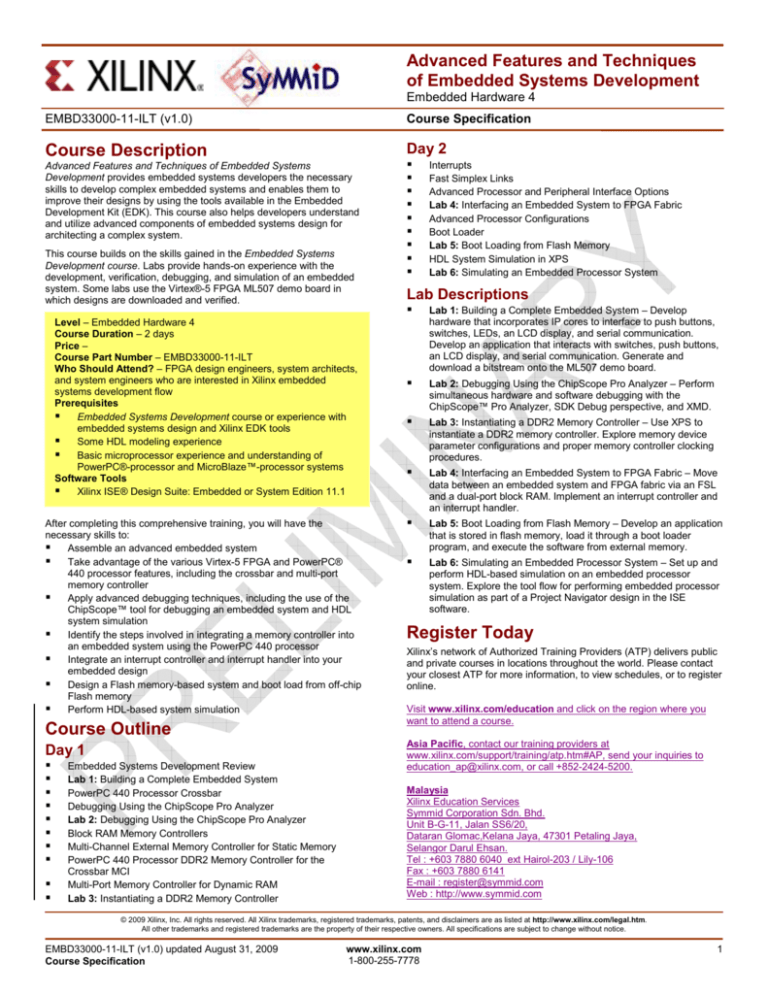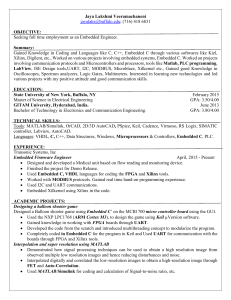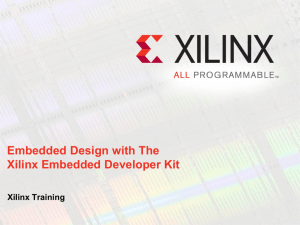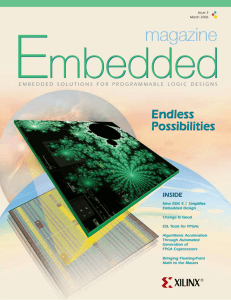
Advanced Features and Techniques
of Embedded Systems Development
Embedded Hardware 4
EMBD33000-11-ILT (v1.0)
Course Specification
Course Description
Day 2
Advanced Features and Techniques of Embedded Systems
Development provides embedded systems developers the necessary
skills to develop complex embedded systems and enables them to
improve their designs by using the tools available in the Embedded
Development Kit (EDK). This course also helps developers understand
and utilize advanced components of embedded systems design for
architecting a complex system.
This course builds on the skills gained in the Embedded Systems
Development course. Labs provide hands-on experience with the
development, verification, debugging, and simulation of an embedded
system. Some labs use the Virtex®-5 FPGA ML507 demo board in
which designs are downloaded and verified.
Level – Embedded Hardware 4
Course Duration – 2 days
Price –
Course Part Number – EMBD33000-11-ILT
Who Should Attend? – FPGA design engineers, system architects,
and system engineers who are interested in Xilinx embedded
systems development flow
Prerequisites
Embedded Systems Development course or experience with
embedded systems design and Xilinx EDK tools
Some HDL modeling experience
Basic microprocessor experience and understanding of
PowerPC®-processor and MicroBlaze™-processor systems
Software Tools
Xilinx ISE® Design Suite: Embedded or System Edition 11.1
After completing this comprehensive training, you will have the
necessary skills to:
Assemble an advanced embedded system
Take advantage of the various Virtex-5 FPGA and PowerPC®
440 processor features, including the crossbar and multi-port
memory controller
Apply advanced debugging techniques, including the use of the
ChipScope™ tool for debugging an embedded system and HDL
system simulation
Identify the steps involved in integrating a memory controller into
an embedded system using the PowerPC 440 processor
Integrate an interrupt controller and interrupt handler into your
embedded design
Design a Flash memory-based system and boot load from off-chip
Flash memory
Perform HDL-based system simulation
Course Outline
Day 1
Embedded Systems Development Review
Lab 1: Building a Complete Embedded System
PowerPC 440 Processor Crossbar
Debugging Using the ChipScope Pro Analyzer
Lab 2: Debugging Using the ChipScope Pro Analyzer
Block RAM Memory Controllers
Multi-Channel External Memory Controller for Static Memory
PowerPC 440 Processor DDR2 Memory Controller for the
Crossbar MCI
Multi-Port Memory Controller for Dynamic RAM
Lab 3: Instantiating a DDR2 Memory Controller
Interrupts
Fast Simplex Links
Advanced Processor and Peripheral Interface Options
Lab 4: Interfacing an Embedded System to FPGA Fabric
Advanced Processor Configurations
Boot Loader
Lab 5: Boot Loading from Flash Memory
HDL System Simulation in XPS
Lab 6: Simulating an Embedded Processor System
Lab Descriptions
Lab 1: Building a Complete Embedded System – Develop
hardware that incorporates IP cores to interface to push buttons,
switches, LEDs, an LCD display, and serial communication.
Develop an application that interacts with switches, push buttons,
an LCD display, and serial communication. Generate and
download a bitstream onto the ML507 demo board.
Lab 2: Debugging Using the ChipScope Pro Analyzer – Perform
simultaneous hardware and software debugging with the
ChipScope™ Pro Analyzer, SDK Debug perspective, and XMD.
Lab 3: Instantiating a DDR2 Memory Controller – Use XPS to
instantiate a DDR2 memory controller. Explore memory device
parameter configurations and proper memory controller clocking
procedures.
Lab 4: Interfacing an Embedded System to FPGA Fabric – Move
data between an embedded system and FPGA fabric via an FSL
and a dual-port block RAM. Implement an interrupt controller and
an interrupt handler.
Lab 5: Boot Loading from Flash Memory – Develop an application
that is stored in flash memory, load it through a boot loader
program, and execute the software from external memory.
Lab 6: Simulating an Embedded Processor System – Set up and
perform HDL-based simulation on an embedded processor
system. Explore the tool flow for performing embedded processor
simulation as part of a Project Navigator design in the ISE
software.
Register Today
Xilinx’s network of Authorized Training Providers (ATP) delivers public
and private courses in locations throughout the world. Please contact
your closest ATP for more information, to view schedules, or to register
online.
Visit www.xilinx.com/education and click on the region where you
want to attend a course.
Asia Pacific, contact our training providers at
www.xilinx.com/support/training/atp.htm#AP, send your inquiries to
education_ap@xilinx.com, or call +852-2424-5200.
Malaysia
Xilinx Education Services
Symmid Corporation Sdn. Bhd.
Unit B-G-11, Jalan SS6/20,
Dataran Glomac,Kelana Jaya, 47301 Petaling Jaya,
Selangor Darul Ehsan.
Tel : +603 7880 6040 ext Hairol-203 / Lily-106
Fax : +603 7880 6141
E-mail : register@symmid.com
Web : http://www.symmid.com
© 2009 Xilinx, Inc. All rights reserved. All Xilinx trademarks, registered trademarks, patents, and disclaimers are as listed at http://www.xilinx.com/legal.htm.
All other trademarks and registered trademarks are the property of their respective owners. All specifications are subject to change without notice.
EMBD33000-11-ILT (v1.0) updated August 31, 2009
Course Specification
www.xilinx.com
1-800-255-7778
1










